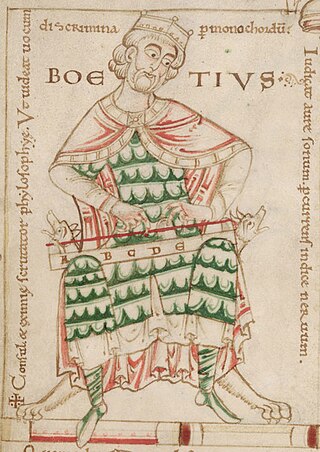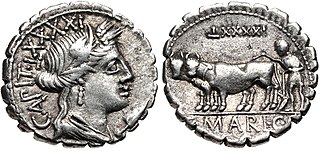Related Research Articles

The Kassites were people of the ancient Near East, who controlled Babylonia after the fall of the Old Babylonian Empire c. 1531 BC and until c. 1155 BC.
Procopius of Gaza was a Christian sophist and rhetorician, one of the most important representatives of the famous school of his native place. Here he spent nearly the whole of his life teaching and writing and took no part in the theological movements of his time.
Nonnus of Panopolis was the most notable Greek epic poet of the Imperial Roman era. He was a native of Panopolis (Akhmim) in the Egyptian Thebaid and probably lived in the 5th century CE. He is known as the composer of the Dionysiaca, an epic tale of the god Dionysus, and of the Metabole, a paraphrase of the Gospel of John. The epic Dionysiaca describes the life of Dionysus, his expedition to India, and his triumphant return. It was written in Homeric Greek and in dactylic hexameter, and it consists of 48 books at 20,426 lines.

Anicius Manlius Severinus Boethius, commonly known simply as Boethius, was a Roman senator, consul, magister officiorum, polymath, historian, and philosopher of the Early Middle Ages. He was a central figure in the translation of the Greek classics into Latin, a precursor to the Scholastic movement, and, along with Cassiodorus, one of the two leading Christian scholars of the 6th century. The local cult of Boethius in the Diocese of Pavia was sanctioned by the Sacred Congregation of Rites in 1883, confirming the diocese's custom of honouring him on the 23 October.

Friedrich Christoph Oetinger was a German Lutheran theologian and theosopher.
Aelius Festus Aphthonius is believed to be the author of a Latin work called De metris omnibus incorporated as part of the Ars Grammatica of the fourth-century AD Christian writer Gaius Marius Victorinus.

The near-open central vowel, or near-low central vowel, is a type of vowel sound, used in some spoken languages. The symbol in the International Phonetic Alphabet that represents this sound is ⟨ɐ⟩, a rotated lowercase double-story a.

Lucius Junius Moderatus Columella was a prominent Roman writer on agriculture in the Roman Empire.
Gaius Marius Victorinus was a Roman grammarian, rhetorician and Neoplatonic philosopher. Victorinus was African by birth and experienced the height of his career during the reign of Constantius II. He is also known for translating two of Aristotle's books from ancient Greek into Latin: the Categories and On Interpretation. Victorinus had a religious conversion, from being a pagan to a Christian, "at an advanced old age".

The Liber de Coquina is one of the oldest medieval cookbooks. Two codices that contain the work survive from the beginning of the 14th century. Both are preserved at the Bibliothèque Nationale in Paris, France.

Hieroglyphic Luwian (luwili) is a variant of the Luwian language, recorded in official and royal seals and a small number of monumental inscriptions. It is written in a hieroglyphic script known as Anatolian hieroglyphs.
The Corpus Scriptorum Ecclesiasticorum Latinorum (CSEL) is an academic series that publishes critical editions of Latin works by late-antique Christian authors.

Theatrum Chemicum is a compendium of early alchemical writings published in six volumes over the course of six decades. The first three volumes were published in 1602, while the final sixth volume was published in its entirety in 1661. Theatrum Chemicum remains the most comprehensive collective work on the subject of alchemy ever published in the Western world.
Peter Wadding was an Irish Jesuit theologian.
Niketas Oryphas or Oöryphas was a distinguished Byzantine official, patrikios, and admiral under the Byzantine emperors Michael III and Basil I the Macedonian, who achieved several naval victories against the Cretan Saracen raiders.
Lectionary 102, designated by siglum ℓ102 – formerly ℓ102a – is a Greek manuscript of the New Testament, on paper leaves. It is dated by a colophon to the year 1370.
De Oratore, Book III is the third part of De Oratore by Cicero. It describes the death of Lucius Licinius Crassus.

The gens Maria was a plebeian family of Rome. Its most celebrated member was Gaius Marius, one of the greatest generals of antiquity, and seven times consul.
The gens Fannia was a plebeian family at ancient Rome, which first appears in history during the second century BC. The first member of this gens to attain the consulship was Gaius Fannius Strabo, in 161 BC.

Artemis Alexiadou is a Greek linguist active in syntax research working in Germany. She is professor of English linguistics at the Humboldt University of Berlin.
References
- ↑ "Commenta in Ciceronis Rhetorica. Accedit incerti auctoris tractatus de attributis personae et negotio. Aims and scope". degruyter.com. Retrieved 29 December 2016.